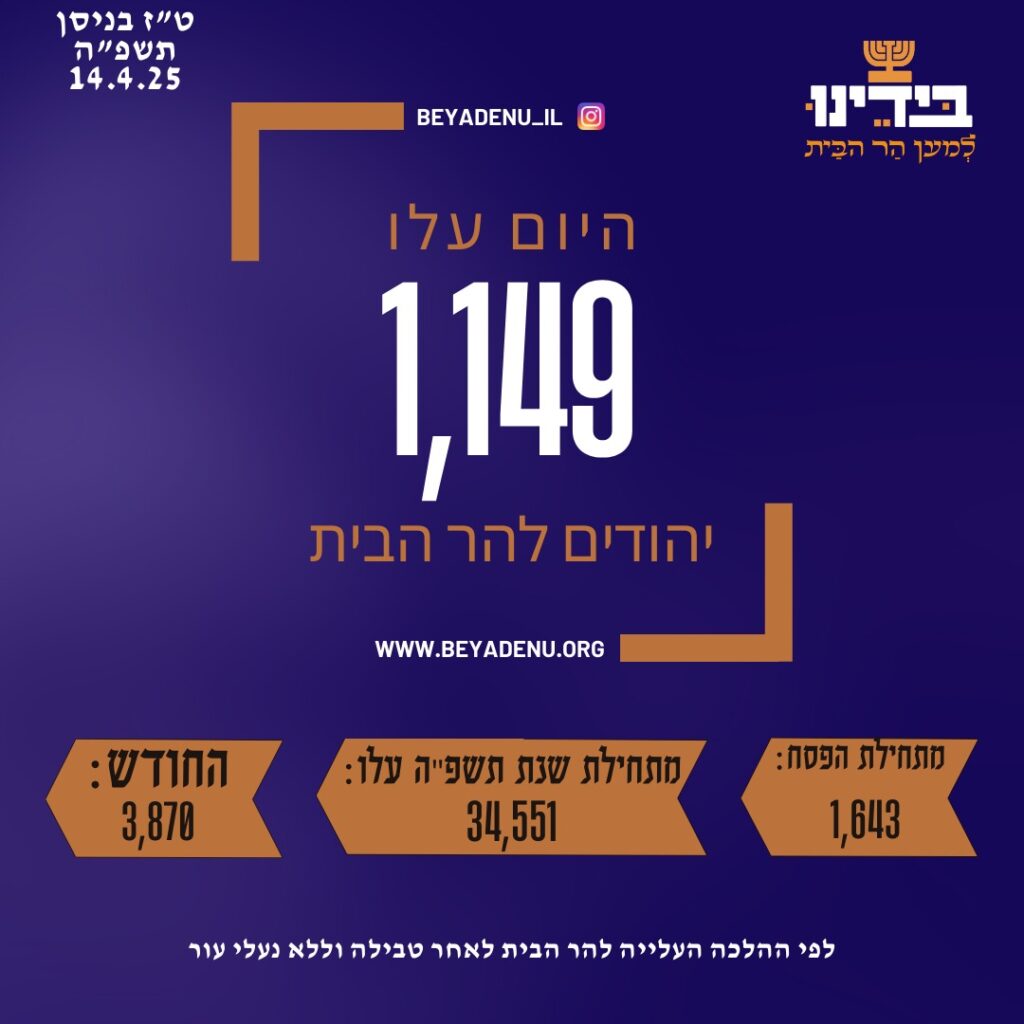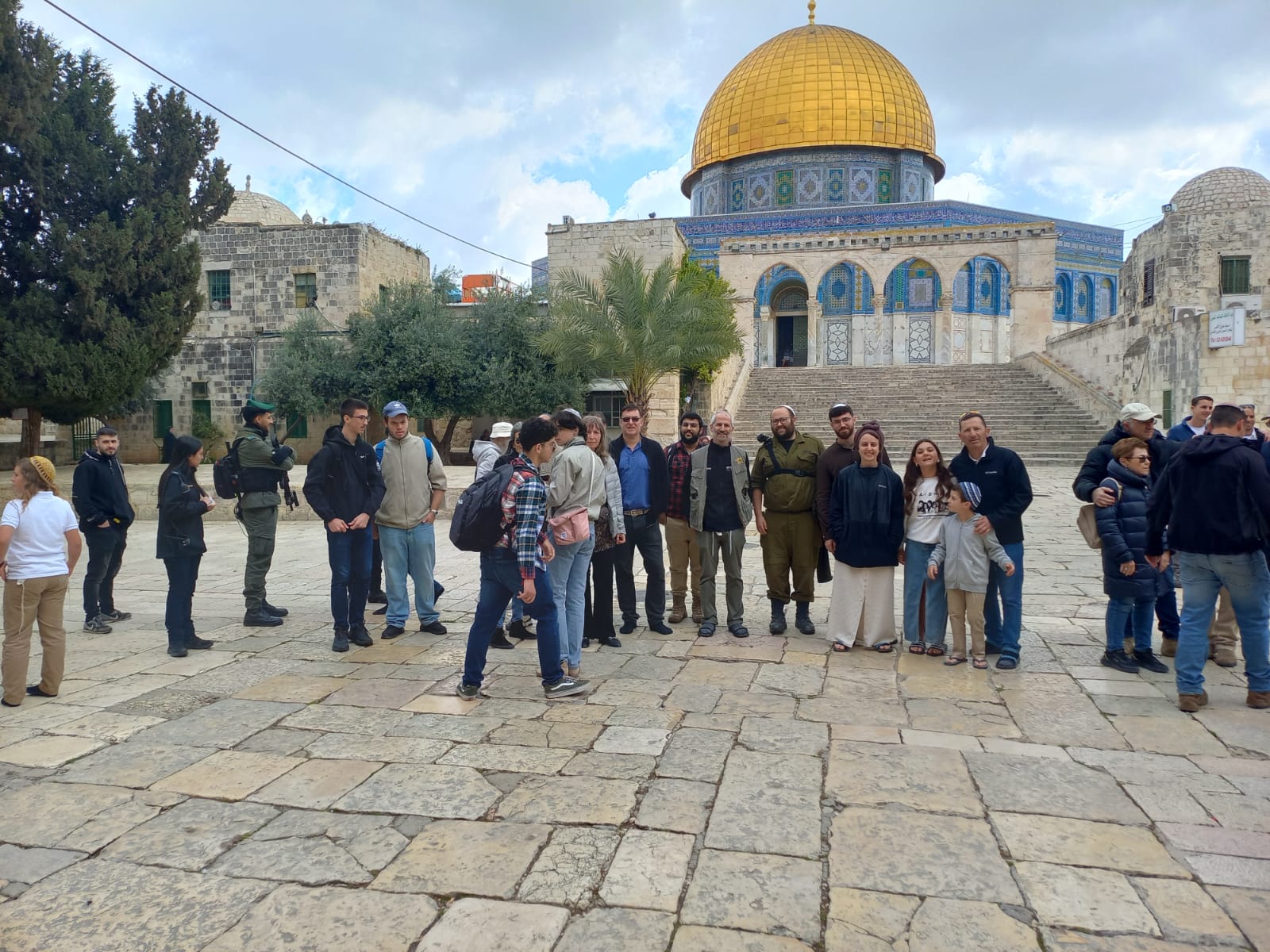On Sunday, the first day of Passover, 494 Jewish worshippers ascended the Temple Mount, where the two Temples stood and Judaism’s holiest site. This marked a 43% increase compared to the previous year, when 345 people visited the site.

According to Beyadenu, a religious activist group monitoring Jewish visits to the Mount, hundreds of Jews participated in morning and afternoon services, including the festive Hallel and Musaf prayers.
This record was set despite limits set on hours of visitation and Jews being banned during Muslim holidays. The Temple Mount is open to non-Muslims Sunday – Thursday, 7:30-11:00 AM, and 1:30-2:30 PM. Non-Muslims are only permitted to enter the site via the Mughrabim/Hallel Gate Gate and must adhere to a strict time frame and path. They must remain in limited groups and are accompanied at all times by a police officer for their safety and to ensure they adhere to the restrictions.
Jews are usually permitted to pray in areas not visible to Muslims but are not permitted to bring books or other holy objects, like tallit and tefillin, used in prayer. So it was surprising when a Jew was sighted wearing a tallit (prayer shawl) on the Temple Mount.

Jew with Tallit on Temple Mount (Photo courtesy Beyadenu)
A spokesperson for National Security Minister Itamar Ben-Gvir, who oversees the Israel Police, told Israel National News on Monday that this increase was a “direct outcome of the policy of the national security minister, which is very different from the policies that were pursued in past years.”
“The policy is to allow free worship for Jews everywhere, including on the Temple Mount,” they stated, adding, “The Temple Mount is sovereign territory in the capital of the State of Israel. There is no law permitting discrimination against Jews on the Temple Mount or anywhere else in Israel, and that is the path Minister Ben-Gvir is charting for the police.”
Since Ben Gvir took office, the hours during which Jews are permitted to enter have been expanded, Jews have been permitted to bow on the Mount, and verbal prayers have been allowed.
Arab media reported the development as “Hundreds of illegal Israeli settlers storm Jerusalem’s Al-Aqsa Mosque to mark Passover” while referring to the holy site as a “flashpoint” and “mosque, while questioning the Jewish “claim” that the temples described in the Bible once stood at the site.
The past Hebrew year saw the number of Jewish visitors to the Mount exceed all previous years since Israel liberated Jerusalem in the 1967 Six-Day War. During the month of Shevat (roughly corresponding to February), more than 3,000 Jews prayed at the site—the highest number since the destruction of the Second Temple in 70 C.E. The Temple Mount Administration noted that despite Shevat traditionally being the least popular time for visits due to rain and cold weather, this year saw a 47% increase in worshippers compared to 2024.
Last month, on the first Friday of Ramadan, an estimated 90,000 Palestinian Muslims ascended the Temple Mount, Judaism’s holiest site. Muslims from Judea and Samaria were permitted to travel to Jerusalem despite Hamas refusing to release the hostages.
In an article first published in 2016, Dr. Kedar, a senior lecturer in the Department of Arabic at Bar-Ilan University, is a long-time advocate for a more precise and accurate understanding of the significance of Jerusalem for some Muslims by dispelling some clear lies perpetuated about the Temple Mount. Dr. Kedar explained that Al-Aqsa is mentioned once in the Koran, and Jerusalem is never named even once.
“Since the Haj pilgrimage is one of the five basic Islamic commandments, the Umayads were forced to choose Jerusalem as their alternative for a pilgrimage site,” Dr. Kedar explained. “In order to justify choosing Jerusalem, the Umayyads rewrote the story told in the Koran, moving the al-Aqsa mosque to Jerusalem and adding, for good measure, the myth of the night-time journey of Mohammed to al-Aqsa. This is the reason the Sunnis now consider Jerusalem their third holiest city.”
“Shia Islam, mercilessly persecuted by the Umayya Caliphate, did not accept the holy Jerusalem canard, which is the reason the second holiest city to Shiites is Najif in Iraq, the burial place of Shiite founder Ali bin Abi Talib. Many of the Shiite elders – Iranian and Hezbollah – only began to call Jerusalem holy after the Khomeni rebellion in 1979 so as to keep the Sunnis from accusing them of being soft on Zionism.”
In a related development, on April 11, the Haifa District Attorney’s Office filed charges against two Arab residents of northern Israel, who were accused of planning an attack on the Temple Mount in collaboration with a terrorist group operating in Judea and Samaria.




